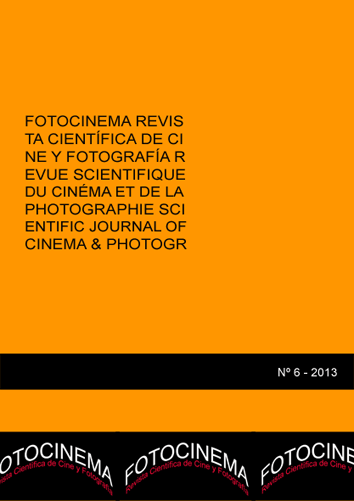Monstruos de la Universal: la etapa silente y los mitos del sonoro
DOI:
https://doi.org/10.24310/Fotocinema.2013.v0i6.5913Abstract
En coincidencia con el centenario en 2012 de los legendarios Estudios
Universal, este trabajo propone unexhaustivo análisis crítico sobre la
construcción de sus principales símbolos terroríficos, la mayoría
inspirados en la literatura, que entre los años 1923 y 1941 conformaron la estructura mitogénica del denominado “monstruo clásico”. Tanto en la etapa silente, como con la irrupción del sonoro, las películas de terror de la Universal marcaron un paso imprescindible en la evolución de este género canónico, y a ellas se debe buena parte del ingente desarrollo posterior del mismo.
Palabras clave: Estudios Universal; terror; monstruos; cine mudo; cine sonoro; mito; novela.
In coincidence with 2012 legendary Universal Studio´s centenary, this paper proposes an exhaustive critical analysis on the construction of its principal terrifying symbols, the majority inspired by literature, which between 1923 and 1941 shaped the myth structure of the socalled "classic monster". In both stages, silent and sonorous movies, the terror of Universal Studios marked an indispensable step in the evolution of this canonical genre, and to them it is owed a good deal of its enormous later development.
Keywords: Universal Studios; terror; monsters; silent movies; sonorous movies; myth; novel.
Downloads
Metrics
Downloads
Published
How to Cite
Issue
Section
License
All contents published in Fotocinema Revista científica de cine y fotografía are protected under the Creative Commons Attribution-NonCommercial-ShareAlike 4.0 International (CC BY-NC-SA 4.0) license. All about this license is available in the following link: <http://creativecommons.org/licenses/by-nc-sa/4.0>
Users can copy, use, redistribute, share and exhibit publicly as long as:
- The original source and authorship of the material are cited (Journal, Publisher and URL of the work).
- It is not used for comercial purposes.
- The existence of the license and its especifications are mentioned.
There are two sets of authors’ rights: moral and property rights. Moral rights are perpetual prerogatives, unrenounceable, not-transferable, unalienable, imprescriptible and inembargable. According to authors’ rights legislation, Fotocinema. Revista científica de cine y fotografía recognizes and respects authors moral rights, as well as the ownership of property rights, which will be transferred to University of Malaga in open access. The property rights are referred to the benefits that are gained by the use or the dissemination of works. Fotocinema. Revista científica de cine y fotografía is published in an open access form and it is exclusively licenced by any means for doing or authorising distribution, dissemination, reproduction, , adaptation, translation or arrangement of works.
Authors are responsable for obtaining the necessary permission to use copyrighted images.













13.png)




